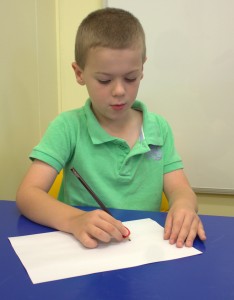
Many children struggle with learning handwriting. Handwriting is a skill that is important throughout school. Younger students face the challenge of learning letter shapes, while older students face the challenge of writing quickly enough to keep up with the workload of school while still writing legibly.
Handwriting is a complex skill. It requires a number of pre-requisite skills including:
Trunk control: A steady trunk is needed as a base for the finely controlled movements of writing. A trunk which is floppy or unstable or one that is too rigid and stiff makes controlling movements difficult.
Shoulder stability: This requires many muscles to work together to hold the shoulder steady so that it can move in slow, controlled movements. Children who find this difficult struggle to produce the fine motor movements required for writing and may try to brace their arm against their side as they work.
Visual motor skills: This skill requires the eye and hand muscles to work together to copy and to form shapes on a page.
Visual perceptual skills: These skills involve the ability of the brain to make sense of information taken in by the eyes. This includes the ability to recognise and remember the shapes of letters and to see differences between letters with similar shapes such as b and d.
Fine motor skills: These skills involve the muscles of the hand and fingers working together to produce the small, controlled movements required for making marks on a page to form letters.

When do children learn handwriting skills?
12-16 Months: Toddlers begin to want to hold pencils or crayons and make scribbles on paper
16-20 Months: Toddlers are able to copy up/down and side to side marks on paper
20-24 Months: Toddlers are able to copy circular scribbles as well as up/down and side to side marks
2-3 Years: Younger preschoolers can copy single lines going up/down and side to side as well as copy a circle with a single line
3-4 Years: Older preschoolers can copy crosses, squares, and diagonal lines
4-5 Years: By the time a child is getting closer to starting school they can copy some letters and numbers and may begin to copy their name.
5-6 Years: In the first year of school children learn to copy most letters, write their name and begin to make letters from memory.
How can I help my child to be ready to develop handwriting skills?
- Help your child to develop gross motor skills to help develop trunk stability and shoulder control.
- Give your child lots of opportunities to develop fine motor skills.
- Provide opportunities for your child to practice paper and pencil activities such as drawing, tracing and colouring.
- Provide opportunities for your child to develop visual skills such as by doing puzzles and matching games.
- Provide opportunities to develop hand and finger strength such as by playing games using pegs, tongs, tweezers, squeeze bottles and droppers.
This web page has lots of fun activities for developing the skills needed for handwriting.
What do I do if I am concerned about my child?
Occupational therapists can assess the underlying skills a child needs for handwriting and work out any areas where a child needs extra support. They can then provide activities specifically targeted at the child's needs and make recommendations about any special equipment that may help. For more information about how an occupational therapist can help your child click here.

How can I support a child who struggles with handwriting?
Positioning is important for children who find handwriting challenging. Here are some tips which may help:
- The table should be no higher than child’s elbow when they are sitting down.
- Have the student sitting with their feet flat on the ground.
- The child's ankles, knees and hips should be bent at bent at a 90° angle.
- A telephone book or something similar under the child’s feet can help if their feet do not sit flat on the floor.
- Tilt paper to the left for right-handed students and to the right for left-handed students.
- Use a writing surface with slight incline (about 20°) such as a slope desk or large ring binder.
- Encourage the child to hold the pencil with the pads of the index finger and thumb, with the pencil resting on the side of the middle finger.
If you are concerned about your child's fine or gross motor skills, visual perception, eye hand co-ordination or handwriting an occupational therapist is the person to see for advice. An occupational therapist can assess your child's skills and advise you on what to do to help your child's development. For more information about occupational therapy check Our website. There are also lots of great activity ideas on the Talking Matters Pinterest page.
Related posts:
Fine motor skills
Occupational therapy
Gross motor skills
Body awareness
Calm alert and learning
Create and learn
Starting school
Top literacy ideas
Early literacy
Reading and writing
What is dyslexia?
Related Blog Posts
If you liked this post you may also like:
Painting and collage
Supporting Your Child While They Do Homework
Playdough Faces
Learn outdoors 40 ways



